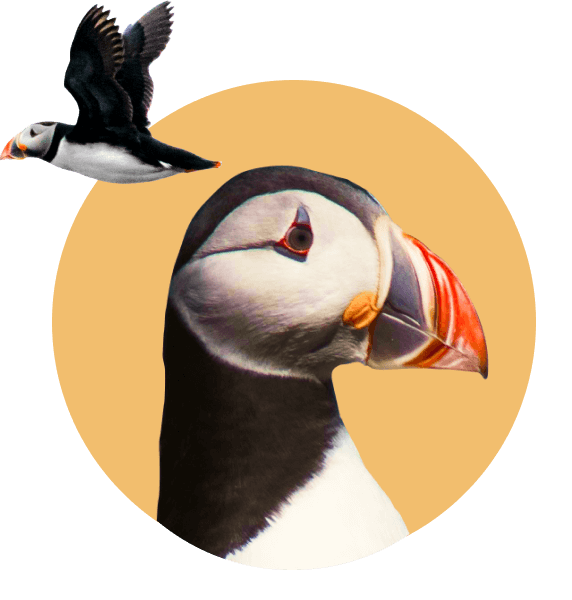
2017 Season Highlights
Sep 11 2017

Basking Shark Season Reflections
We’re now into September and have returned to Oban from the islands. Time flies and our Hebrides season is over for another year, it’s been such a blur! Reflecting on the season, we had a very challenging peak summer for weather with the jet stream out of position and acting as a low-pressure conveyor. Situated on the edge of the Atlantic means we’re first in the firing line for strong winds! After such a promising spring and fantastic spring we were hoping for a nice summer. We can’t control the weather and our hard-working crew made the best of the weather windows for our clients! Shark numbers were good this year, some of the best days saw over 30 sharks. Sightings stats for our longer tours were still 100% success rate, but our shorter trips did suffer a little with our day trips at around 75% trip success. This is still amazing for an elusive underwater giant of the North Atlantic and our best advice is to come on the longer tours which give some flexibility with the weather and sightings. This season our total numbers are around the 250 mark, however we still have our Autumn Research Programme & other public sightings, which will probably end up around at 300 for the year.
Basking Shark Science
Our scientific programme continued to monitor the population of sharks and we collected a lot of data. Spending so much time in the water with the sharks allows us to gather lots of information that could never be captured from a boat. Examples could be male/ female assemblages, lamprey presence and location, along with numerous other parameters. Some of the data is used to test site fidelity of the sharks and one example from this year was a distinctive shark we called ‘Floppy Fin’. This shark had a collapsed dorsal fin (unusual but not unheard of) which we re-sighted over the period of a week in a distinct area. This adds to the information about how long individual sharks are resident for.
Injured Bottlenose Dolphin Re-Sighting
Over the season we also had many other wildlife re-sightings such as the injured bottlenose dolphin we first saw in the spring. This dolphin had a very distinctive-looking healed injury near its tail fluke so it was very easy to identify. We re-sighted this individual numerous times over the summer and it seemed healthy on all occasions surrounded by other members of its pod. You can read a previous blog here on a small sightings survey we took earlier in the year to track this individual around the area. It will be great to add to these records so a life history can be kept on the individual. Perhaps one day adding to the understanding of the healing powers of dolphins after injuries.
Distinct Minke Whale
Minke whales are abundant around the Inner Hebrides and are the smallest of the baleen whales. With deep water (over 200m) close to our base we have had numerous encounters with them over the season. On some occasions, they were observed lunge feeding, surfing waves and we also spotted this individual with a very distinct dorsal fin. We’re hoping that this individual can be identified using the same photo ID techniques that we use with the sharks. There are a variety of organisations that are dedicated to cetaceans and we’ll follow up with them to see if there are any matches
Sea Eagle Fledglings
One of the islands we pass a lot in the boats is Mull and it’s home to a large population of white-tailed sea eagles. There are rumoured to be around 20 breeding pairs. We see numerous adults throughout summer, and we had the pleasure to observe at least two chicks eventually fledge and spread their wings. Hopefully, these eagles will find their own territories around the islands and expand the flourishing population. It’s great to see these predators back in the landscape after going extinct through persecution in the early 1900s. They are an emotive topic and we enjoy having discussions with our guests about the pros and cons of re-wilding. This image was from just a few days ago when we spotted this year’s fledgling in the distant trees, they are much darker (brown) with no white tail. This one was also getting harassed by a raven – although we think once the eagle grows up a bit, maybe the raven won’t be so bold!
New Underwater Reef Found
Onto our underwater exploring, we did find a new soft coral reef this year after promising topography was spotted on the boat’s echo sounder. A kelp wall to around 15m leading to a large soft coral plateau in 25m of water and an intriguing wall dropping off to the depths well beyond 40m. We’re looking forward to exploring here in the future – see below for a short video to give you an idea of the beautiful scenery.
Free Diving Tour
2017 was the first year we ran a free-diving specific tour after seeing an increase in the number of free divers (long fins) appearing on our other tours. All our guides use free-dive techniques and over the years we’ve found numerous amazing spots. We noted that people with skills in breath-hold would really enjoy them so we set up a specific trip to visit them. Our guests came from England, France, Germany & the Netherlands and we had a great trip with them. We’ll write up a specific blog on this soon! In the meantime see an image from some of our sea cave exploring on the tour. There are some amazing archways with clear water and rich marine life. It’s always rewarding to hear people blown away by the North Atlantic marine life when they have been used to warmer waters!






